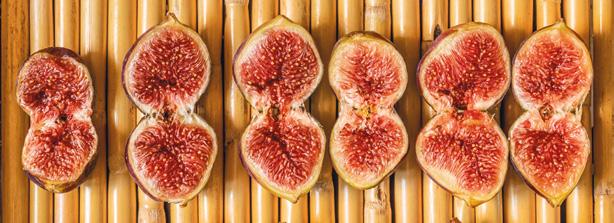
2 minute read
IL SAPORE - THE FLAVOUR
FICO, IL FRUTTO DALLE TANTE VITE
The fig, a fruit that lives many lives
¬ Stefania di Mitrio
RIPIENO DI MANDORLE, RICOPERTO DI CIOCCOLATO O IMBOTTITO DI CAPOCOLLO DI MARTINA FRANCA, FRESCO O COTTO, È SEMPRE PRESENTE SULLE TAVOLE PUGLIESI.
Stuffed with almonds, covered with chocolate or stuffed with capocollo from Martina Franca, freshly picked or cooked, the fig is a protagonist of the Puglian table.
FOTO
Le origini. È un frutto antichissimo. Si dice che furono i Fenici a diffonderlo nelle isole del Mediterraneo, mentre in Italia la sua coltivazione risale all’antica Roma.
La stagione. È un frutto, sapientemente conservato per accompagnare l’inverno, che matura da giugno a settembre. Quello che si raccoglie a inizio estate viene chiamato fiorone: ha forma, colore, sapore e grandezza differente e viene gustato esclusivamente fresco.
In cucina. Dolce e dal gusto morbido, il fico da sempre caratterizza la tradizione culinaria pugliese nei piatti dolci e salati. Si gusta fresco oppure secco (viene essiccato al sole su un graticcio sino a quando la sua buccia diventa rugosa e non perde più succo). Non c’è famiglia in Puglia che non sappia realizzare ricette succulente da offrire agli ospiti: fichi ripieni di mandorle, ricoperti di cioccolato o in versione salata imbottiti di capocollo di Martina Franca, altra eccellenza pugliese. Dai fichi si ricava anche il vincotto, uno sciroppo dolce che si ottiene dalla loro bollitura per molte ore.
La chicca da scoprire. Il conservatorio botanico “I giardini di Pomona”, a Cisternino, custodisce un’importante collezione dedicata al ficus carica (il fico per l’appunto), di cui esistono ben 600 varietà (info www. igiardinidipomona.it). Un luogo magico per scoprire di più sulle varietà di questa pianta. The origins. It is a very ancient fruit. It is said that it was the Phoenicians who spread it to the islands of the Mediterranean, while in Italy its cultivation dates back to ancient Rome.
The season. This fruit, wisely preserved to be a winter companion, ripens between June and September. When harvested in early summer is called “Fiorone”: it changes its shape, colour, taste and size, and you have to taste it exclusively freshly picked.
How to cook it. With its sweet and smooth taste, the fig has always featured the Puglian culinary tradition. You can eat it fresh or sundried (placed on a traditional rack under the sun until their skin becomes wrinkled and they lost their moisture). Every Puglian family knows how to make delicious recipes to offer to its guests: figs stuffed with almonds, covered with chocolate or in a savoury version stuffed with capocollo from Martina Franca, another Puglian excellence. From figs you can also get the “vincotto”, a sweet syrup obtained by boiling figs for many hours.
Insider tip. "I giardini di Pomona", a botanical garden in Cisternino (Brindisi), holds an important collection of more than 600 varieties of the ficus carica (the fig, indeed). A magical place to find out more about the variety of this plant. (info www.igiardinidipomona.it).










